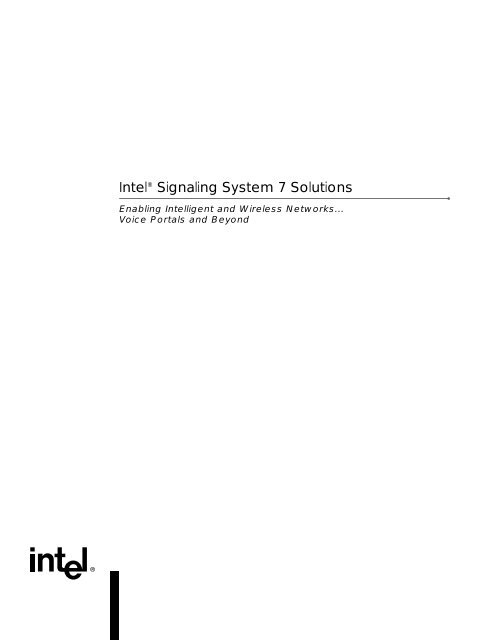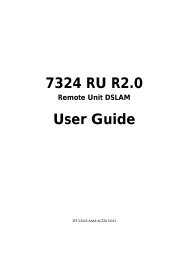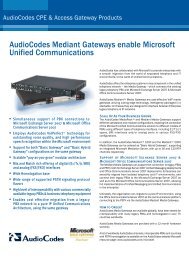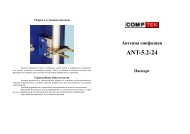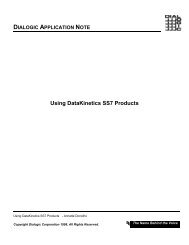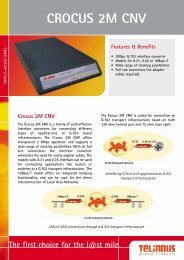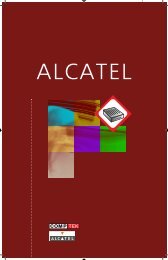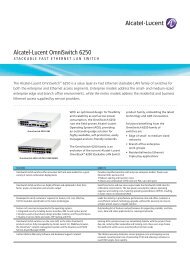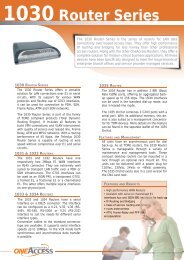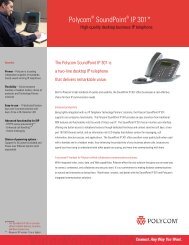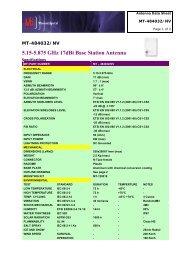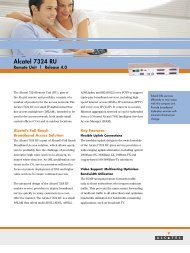Intel® Signaling System 7 Solutions - CompTek
Intel® Signaling System 7 Solutions - CompTek
Intel® Signaling System 7 Solutions - CompTek
You also want an ePaper? Increase the reach of your titles
YUMPU automatically turns print PDFs into web optimized ePapers that Google loves.
Intel ® <strong>Signaling</strong> <strong>System</strong> 7 <strong>Solutions</strong>Enabling Intelligent and Wireless Networks...Voice Portals and Beyond
ISUP / TUPCustomer ApplicationApplication Part(GSM-MAP, IS-41,INAP)TCAP◗ Global <strong>System</strong> for Mobile Communications-MobileApplication Part (GSM-MAP), Interim Standard-41(IS-41), and Intelligent Network Application Protocol(INAP) These are transaction-based services that allowdevelopment of applications such as Short Message Service,and access to Home Location Register (HLR)/Visitor LocationRegister (VLR) for wireless networks, and other IntelligentNetwork applications.NOTE: IS-41 is also known as TIA-41.SCCP1.3 Advantages of SS7MTP3MTP2MTP1Figure 2: SS7 Protocol Architecture1.2 Protocol ArchitectureSS7 is a layered software architecture that consists of messagetransfer and user parts.Message Transfer Part (MTP)◗ MTP1-3 (transport) MTP provides the physical, link, andnetwork layer functions. The overall purpose of MTP is totransport information reliably from the upper layers (includingthe user parts and SS7 applications) across the SS7 network.User Parts◗ ISDN User Part/Telephone User Part (ISUP/TUP)ISUP/TUP provides standards-based and network-specific callcontrol services for wireless and wireline public networks◗ Signal Connection Control Part (SCCP) SCCP providesaddress resolution services (i.e., global title) for locatingservices in the network◗ Transaction Capabilities Application Part (TCAP) TCAPtransports transaction-oriented data across the SS7 networkand implements standard Remote Operation Service Element(ROSE) services for applications such as GSM-MAP and IS-41. These “applications” provide Intelligent Network servicessuch as home location register or Short Message Service.◗ Faster call set up◗ More efficient use of network resources◗ A tested and reliable signaling protocol with global acceptance◗ Support for network convergence◗ Support for large, high-density, high-reliability systems◗ Scalable architecture◗ More cost-effective than Integrated Services Digital Network(ISDN) and Channel Associated <strong>Signaling</strong> (CAS)2.0 SS7-Enabled ApplicationsA field-proven, highly versatile solution, <strong>Signaling</strong> <strong>System</strong> 7 isused extensively in network and carrier-based applications andinfrastructure because of the substantial benefits it offers. Thefollowing scenarios demonstrate how you can use Intel ® SS7building blocks to create applications in different markets.VoIP GatewayVoice over Internet Protocol (VoIP) gateways enable callsplaced over an Internet Protocol (IP) based network to be routedseamlessly to telephones on the public network. That is to say,they make it possible for the circuit-switched public telephonenetwork to talk to an IP packet-based network, and vice versa.With the rapid growth of IP-based voice, and its increasingadoption by major carriers and corporations, gateways aregrowing in size and now support thousands of calls. This increasein scale and the need to implement carrier-grade IP gateways hasmade SS7 the protocol of choice for connecting IP gateways topublic telephone networks. An added advantage is that the PSTNalready uses SS7 as its signaling mechanism of choice. Supportfor SS7 is crucial if VoIP-based services are to provide telephoneservice that can connect to users on public networks.2
Enhanced ServicesCarriers are currently offering a wide variety of enhanced servicesincluding voice and fax messaging, one-number/follow-me, andpre-paid services to their customers. SS7 provides access to thedatabase lookup capabilities on which these services depend, usingcall control and messaging functions between the central officeswitch (SSP) and the Service Node or Intelligent Peripheral.Wireless NetworkSS7 plays an important role in both wireline and wirelessnetworks. As the basis for GSM and IS-41 networks, SS7allows wireless subscribers capabilities such as automaticroaming, which are transparent to the user.Wireless networks incorporate advanced and comprehensivesignaling and control systems. Even when the mobile unit iswithin its home network, location tracking is required forauthentication, hand-off functions, and call termination.<strong>System</strong> operators are looking to offer their customersincreasingly sophisticated levels of mobility, all of whichcan be provided by SS7’s advanced signaling functions.Call CenterSS7 can be used in large call centers to improve efficiency, providenew functionality, and reduce telecommunications costs. SS7provides answer and call termination supervision, resulting in moreefficient operation and lower operating costs. Key benefits of usingSS7 in an outbound call center application include:◗ Faster call set-up, answer detection, and call tear-down◗ Ability to include more information with the call◗ Ability to reduce telecommunications costs by leasingor purchasing high-capacity trunks◗ Easy upgrade to new services3.0 Intel ® SS7 <strong>Solutions</strong>The Intel SS7 product line consists of boards as well as serverand software solutions that are designed to meet a wide variety ofcustomer requirements. A complete SS7 software stack is providedto run on these products.Intel offers a modular, open architecture for building functional,reliable, cost-effective public network applications and services.In addition, Intel SS7 products can be used to build SS7 networkelements (NEs) and Advanced Intelligent Network (AIN)platforms such as:◗ Service Control Points (SCP)◗ Intelligent Peripherals (IP)/ Service Nodes (SN)◗ Signal Switching Points (SSP)◗ Signal Transfer Point (STP)◗ SS7-IP <strong>Signaling</strong> Gateway (SG)◗ Home Location Register (HLR)◗ Visitor Location Register (VLR)◗ Authentication Center/ Equipment Identification Register(AuC/EIR)◗ Mobile Switching Centers (MSC)◗ Radio Network Controller (RNC)◗ 3G Serving General Packet Radio Service Support Node(SGSN)◗ 3G Gateway General Packet Radio Service Support Node(GGSN)ApplicationsThese SS7 network elements can be used in both wireless andwireline networks. Common applications include:◗ Voice portals◗ Follow-me/one-number services◗ Voice mail and unified messaging◗ Voice-activated dialing◗ Short messaging services◗ Network call center◗ Call completion◗ Least-cost routing /telecom resale◗ International callback◗ Local number portability◗ 800/Freephone◗ Caller ID◗ Virtual private network (VPN)◗ Prepaid phone/calling card3
TCP/IPITU-T SS7XXXXSS7 NetworkSTPSTPXDSC210ANSI SS7XPBXPBXInternetGatewayUnifiedMessagingVoIPGatewayVoIPNetworkTheInternetFaxPBXEmailFigure 3: DSC Unit within a Network3.1 Intel ® SS7 Hardware OfferingsSS7 Digital <strong>Signaling</strong> ConverterThe digital signaling converter (DSC) works within an existingnetwork as an intelligent switch. Housed inside the DSC unit areIntel SS7 boards and the application software needed to providea variety of turnkey solutions. DSC capabilities include:◗ Connection to eight adjacent, or 32 non-adjacent switches(via STPs)◗ Simultaneous use of ANSI, ITU-T, China, French, UK,and Japan SS7◗ On-box number translation (with whitelist and blacklist)◗ Dual redundant configuration◗ In-call parameter manipulation (ANI, DNIS, etc.)◗ Ability to connect to a remote PC via IP for number translation,advanced routing, billing, statistics, etc.The DSC can convert a wide variety of protocols including:◗ One variant of SS7 to another◗ ANSI◗ ITU-T◗ China No 7◗ Japan◗ SS7 to ISDN◗ Access protocols— NI2— Q.931— QSIG— DPNSS4
Customer Control Application— Drives ISDN and Voice— Does not know about SS7ISDN/QSIG/DPNSS(<strong>Signaling</strong> and Voice)ISUP <strong>Signaling</strong>VoicePortalDSC210STPVoicePortalPSTNLANClear ChannelVoiceISDN/QSIG/DPNSS(<strong>Signaling</strong> and Voice)Figure 4: ISDN-to-SS7 ConversionIntelligent switching functions of the DSC unit includes:◗ Routing based on the dialed number◗ Prefixing/deleting of routing digits◗ Conversion from overlap signaling to en-bloc signaling◗ Automatic retry and re-route◗ Configurable circuit selection (hunting)ISDN-to-SS7 ConversionSome developing countries use SS7 to connect telephoneequipment to the public network. Let us suppose that you owna small company that has the opportunity to sell a substantialamount of voice portal equipment in one of these countries. Theproblem is that your products only support ISDN connectivity.The digital signaling converter can solve this problem easily.Think of it as a signaling appliance. No changes are requiredto your existing ISDN-based application. All the configurationdetails for ISDN and ITU ISUP can be contained within theDSC unit. It can be treated as a black box once it is configured.SS7 Benefits in this Application◗ Existing hardware and software require no modificationsignaling mode operation. In signaling-only mode, you canuse many ISDN D-channels with single or multiple SS7signaling links.Intel ® Offering◗ Two servers with Intel ® Pentium ® processors (shown as VoicePortals in Figure 4) running Windows ® 2000 or Linux— Host the application— Contain Intel ® Dialogic ® brand T-1 or E-1 voice boards toterminate voice circuits• A D/600JCT-2E1 board, for example◗ One DSC210 board— Terminates SS7 signaling to and from the network• MTP layers 1-3 (lower level messaging)• ISUP signaling (call control protocol)— Terminates ISDN/QSIG/DPNSS signaling to and fromDialogic boards— Passes audio from PSTN side of DSC to the Dialogicboard side of the DSC◗ Opens new markets segments without requiring additionaltime and money to modify applications to make them SS7compatibleNOTE: With signaling conversion, the number of inboundand outbound T-1 circuits must be equal when using voice and5
Clear Channel VoiceANSI SS7ITU SS7User in United StatesDSC210User in ArgentinaSTPSTPANSI ISUP <strong>Signaling</strong>ANSI ISUP <strong>Signaling</strong>Figure 5: SS7-to-SS7 Network ConversionSS7-to-SS7 Network ConversionImagine that a network operator has both an ITU SS7 networkand an ANSI SS7 network and is currently paying a third party todo the protocol conversion. Under these conditions it would makesense for the network operator to build an interface between thetwo SS7 networks. The cost savings would mean lower rates forthe customers.In addition, situations may arise where equipment was purchasedthat does not interoperate with a carrier’s other equipment. Thishappens occasionally. SS7 to SS7 conversion will, for example,allow an ITU-T based feature server to operate in an ANSI network— or an ANSI modem bank to interconnect to an ITU-T network.The digital signaling converter (DSC) offers solutions for thesekinds of problems and has these additional features:◗ Parameter Manipulation◗ Whitelist◗ Blacklist◗ Global Title◗ Local Number Portability— Using the Intelligent Service Control optionSS7 Benefits in this Application◗ Protocol conversion◗ No application code requiredIntel ® Offering◗ One DSC unit— Terminates SS7 signaling to/from ITU SS7 network• MTP layers 1-3 (low-level messaging)• ISUP signaling (call control protocol)— Terminates SS7 signaling to and from ANSI SS7 network• MTP layers 1-3 (low-level messaging)• ISUP signaling (call control protocol)— No audio transmission is required— The T-1/E-1 spans should be configured as“clear channel”• No A-Law/µ-Law conversion is providedPre-Paid Wireless ServiceCustomers can prepay for cellular service and avoid havingto sign a long-term contract with their cellular provider. Anautomated Voice Response Unit (VRU) can be used to keep usersinformed about the number of remaining minutes they have. Thefollowing example uses SS7 ISUP signaling for call control toconnect to the VRU and SS7 TCAP messages for associating thecellular phone number with the remaining number of minutes.SS7 Benefits in this Application◗ Roaming◗ Permits a “Brand X” cell phone to use the name brand celltowers and Mobile Switching Centers— The billing is handled by SS7 and TCAP◗ Prepaid credit notification via Short Messaging Service (SMS)— Customers are told how many minutes of call time remain6
VoiceClearChannelVoicePSTNSIUPrepaidCellPhoneLANA LinkSTP<strong>Signaling</strong> LinkA LinkSCPFigure 6: Pre-Paid Wireless Service◗ Message waiting service— Customers are told someone is attempting to call themwhen they are on another call— Uses SMS◗ Targeted advertising— For example, if a subscriber has just landed in Washington,D.C. and uses the phone for the first time, the serviceprovider can send short informational messages such aslocal events of interest◗ Call set up time— SS7 reduces call set up to a few seconds, which translatesinto a rapid return on investment• If R2/MF is used instead of SS7, it can take ten or moreseconds to place an outbound call. The user must waiteven longer, resulting in a higher bill.Intel ® Offering◗ Intel Pentium based server containing:— T-1 or E-1 voice boards to terminate voice circuits— A DM/V960A-4T1, for example◗ SIU131 server to terminate signaling and communicatewith SCP— MTP layers 1-3◗ Ethernet ® network running TCP/IP to connect the two serversVoice PortalA large specialty products company is seeking to improve customerservice by allowing customers to access information about theirorders 24 hours a day. Naturally, they hope to add this service atminimal expense. They have decided to use Automatic SpeechRecognition (ASR) and Text To Speech (TTS) to reduce thenumber of agents required to support around-the-clock service.The company has also chosen to use SS7 to connect to the PSTN.SS7’s faster call set up supports high-quality customer service,and it also provides reliable disconnect supervision, whichensures that the company is only paying for the actual time thatusers are connected. This represents a substantial improvementover the company’s current system, which cannot detect whencallers hang up. The company is billed for the extra time thatelapses before the disconnect is detected.When the application receives indication of an incoming call,it compares the calling number with an existing database ofcustomer telephone numbers. If the number is found in the database,the caller can confirm his/her identity with a password andcheck the account balance, order status, or shipping status. If thecalling number is not found in the database, the application willprompt the caller for an account number. The calling number andaccount number will then be entered into the database for futurereference. The added security this provides is a major benefit tobanks and other financial institutions.— ISUP signaling— SCCP/TCAP protocols7
Customer Database:— Order Status— Shipping Status— Account BalanceCustomer Control Application— Drives Database, Voice and SIU's19" RackVoiceT1 or E1 SpansPSTNVoiceSTPSIU ASIU BA LinksSTPPOTS PhoneLANFigure 7: Voice PortalSS7 Benefits in this Application◗ Provides faster call set up, reliable disconnect, and security◗ A dual signal interface unit (SIU) configuration will provideresilience not available with ISDN or CAS signalingIntel ® Offering◗ One server with an Intel ® Pentium ® processors runningWindows* 2000 or Linux— Hosts the customer’s application◗ Two servers with Intel ® Pentium ® processor runningWindows 2000 or Linux containing:— T-1 or E-1 voice boards, utilizing CSP technology,to terminate voice circuits• A DM/V1200A-4E1, for example◗ Two SIU231 boards to terminate SS7 signaling— MTP layers 1-3 (lower level messaging)Short Message Service (SMS)A company that leases vending machines can save money on fuelby reducing the number of trips required to restock its machines.Keeping the machines restocked will also increase profits. Thesegoals cannot be achieved using a routine, once-a-week deliveryschedule. The company needs to be able to monitor the machineson an ongoing basis. One way to do this uses the Short MessageService (SMS) available on SS7. SMS employs store-and-forwardmessaging using the MAP protocol. No audio transmission isrequired here, only signaling.Company trucks can also be configured to send location informationvia an onboard global positioning device, using UnstructuredSupplementary Services Data (USSD), an SS7 feature. USSDallows point-to-point communication and is not subject to thestore-and-forward delay inherent in SMS messaging.SS7 Benefits in this Application◗ This kind of application could not exist without SS7MAP messaging— ISUP signaling (call control protocol)8
Credit CardCompanyEdwinPSTN/’SS7MariaDSC-210#1STPSCPCustomerControlApplicationDSC-210#2LANFigure 10: Intelligent NetworkSS7 Benefits in this Application◗ Customer grows market segment by adding SS7 connectivity◗ A field-tested SS7 stack◗ Hardware manufacturers can remain focused on theircore competenciesIntel ® Offering◗ Intel i960 ® Control Processor on the manufacturer’s board◗ Intel IXP1200 ® Network Processor on the manufacturer’s board◗ Running the SS7 software stack◗ SS7 licensed software for the desired protocols— MTP1-3 and ISUP, in this exampleDSC Intelligent NetworkImagine that a customer (“Edwin”) is tired of receiving unsolicitedtelephone calls from credit card companies offering a lower introductoryrate. Edwin calls his local telephone company and asks ifhe can block all calls from certain telephone numbers. His serviceprovider is pleased to tell him that this service is available foronly a few dollars a month. Here’s how it works.The service provider sets up a “blacklist” of callers—identifiedby their telephone numbers—that are blocked from reaching thecustomer. After two months of peace, Edwin decides to blockall callers whose telephone number he does not recognize. Theservice provider removes the blacklist and sets up a “whitelist”of acceptable telephone numbers, which Edwin has determinedin advance. All other callers will get a message telling them thattheir call cannot be completed.Figure 10 shows that Edwin has added Maria to his whitelist.However, when the credit card company, or anyone else not onEdwin’s list calls, the call will not go through, and Edwin will notbe inconvenienced.SS7 Benefits in this Application◗ Provides the underlying technology that makes the callblocking service possibleIntel ® Offering◗ One server with an Intel ® Pentium ® processor runningWindows 2000 or Linux:— Hosts the application— T-1 or E-1 voice boards to terminate voice circuits• A DM/V1200A-4E1 board, for example◗ Two DSC units (for resilience), plus Intelligent ServiceControl (ISC) Software— Terminate SS7 signaling to and from ITU SS7 network• MTP layers 1-3 (low-level messaging)• ISUP signaling (call control protocol)10
IADCable or DSLNetworkPSTN/SS7Pots PhoneDSLAccessMultiplierJulieCustomerSoftswitchApplicationTrunkingGatewayServer withV.35 Serial(or E1) SS7ConnectionSTPSCPLANFigure 11: Softswitch— Terminate SS7 signaling to and from ANSI SS7 network• MTP layers 1-3 (low-level messaging)• ISUP signaling (call control protocol)— No audio transmission is required• The T-1/E-1 spans should be configured as“clear channel”• No A-Law/µ-Law conversion is providedSoftswitchCable companies and broadband service providers are increasinglylooking at voice services to generate revenue. Their goal is toprovide toll-quality service plus enhanced features using theirexisting cable or DSL connections. The equipment is already inplace to route a broadband signal from the cable/DSL network toeach user, but a PSTN connection must be added on the networkside to enable voice.Figure 11 shows one method for accomplishing this. The voiceinformation is carried to/from each subscriber using InternetProtocol (IP). IP call control is used to handle the traffic from theprovider’s head end to a user’s Integrated Access Device (IAD).IP traffic is converted for transit on the PSTN at the head end.SS7 is used to integrate the TDM-based traffic with the PSTN.SS7 Benefits in this Application◗ Integrate the TDM-based traffic with the PSTN◗ Allows users to configure call handling— Call forwarding— Ringing order (cell, office, home, or all at once)Intel ® Offering◗ Intel 32-bit platform to run the application.◗ Intel licensed SS7 software for the desired protocols— MTP1-3 and ISUP, in this example11
INAPTCAPSCCPMTP Level 3MTP Level 2ISUP◗ INAP—ITU, ETSI, Telcordia◗ MAP—ETSI (MAP GSM), ANSI (MAP IS-41)Benefits◗ Fully portable, hardware-independent products enableintegration into any processor and operating system◗ Simple, fully featured, and flexible interfaces◗ Mature product, integrated into a wide variety of solutions,ensures interoperability◗ Accurately implements standards and assures interoperabilityBroadband SS7 StackMTP Level 1Figure 12: Complete Narrowband SS7 Stack3.2 Intel ® SS7 Software OfferingsNarrowband SS7 StackFor applications designed to handle greater traffic and requiringmore processing power, Intel offers a broadband version of theSS7 stack.◗ MTP Level 3 – B—Broadband signaling, message handling,and network management◗ Q.2140—SS7-to-ATM convergence◗ Q.SAAL—Reliable transfer of data and signaling messages◗ AAL/ATM—Physical interfaceThe Intel SS7 telephony software source code solutions enhanceand extend the signaling capabilities of telecommunicationsnetworks. The solutions offer a complete standards-basedimplementation and are ideal for equipment manufacturersseeking to reduce time to market by using proven products. Intelcarrier-grade SS7 products provide scalability, security, quality,reliability, speed, and increased network utilization for the convergednetwork.Intel ® OfferingIntel offers extensive support for:TCAPSCCPBB/NBInterworkingB-ISUP◗ MTP2—ITU (can be used for China), ANSI, NTT, TTCMTP Level B◗ MTP3—ITU, ANSI, NTT, TTC, China, ETSI, Telcordia*◗ MTP3-B—ITU (B-ICI), ANSI, TTC◗ ISUP—ITU (can be used for China), ANSI, ETSI, Telcordia,NTT, FTZ, Italy, Singapore, Russia◗ TUP—China◗ SCCP—ITU, ANSI, ChinaMTP Level 2MTP Level 1Q.2140Q.SAALAAL/ATM/PHY◗ TCAP— ITU (can be used for PRC), ANSI, ETSI, TTCFigure 13: Complete Broadband SS7 Stack12
UserApplicationProtocol LayerOut of ServiceUpdate MessagesProtocol LayerActiveProtocol LayerUpdate MessagesProtocol LayerNetworkFigure 14: Fault-Tolerant High-Availability SolutionBenefitsThis stack can be used in a variety of network elements including:◗ Mobile Switching Centers (MSC)◗ Radio Network Controller (RNC)◗ Serving General Packet Radio Service Support Node (SGSN)Fault-Tolerant High-Availability <strong>Solutions</strong>Intel provides fault-tolerant, high-availability (FT/HA) communicationlayers and stacks. These can be classified as applications thatprovide services to a system user. An FT/HA solution maintainsactive calls during software and hardware failures. The Intelsolution is provided in the software and gives system designers andengineers total freedom when choosing their hardware platformand operating system (kernel or user space). Developed primarilyfor telecommunications products, the Intel solution is alsoapplicable to other types of products requiring high availability.The FT/HA architecture lets you replicate a node and turn thesenodes into an FT/HA system. Most equipment manufacturers usedual-processor architecture with active and standby subsystems.The Intel FT/HA solution enables the standby subsystem tomaintain state information through state updates from the activesubsystem. These updates prevent the loss of state information,enabling an orderly switchover from the failed subsystem to thestandby subsystem. Figure14 illustrates this functionality.Benefits◗ Increased system availability via software redundancy◗ Essential for 99.999% (“five-nines”) carrier-grade availabilityrequirementsIntel ® Advantages◗ Modular— Add-on components◗ Offers software-based, active-standby configuration forredundancy◗ Increased system availability via software redundancy◗ Fault-tolerant and non-fault-tolerant protocol layers canco-exist◗ Active and standby layers can reside in different locations◗ Controlled (manual) and forced (automatic) switchoverDistributed Fault-Tolerant13
Upper LayerUpper LayerLoad DistributionFunctionLoad DistributionFunctionCopy 1(Active/Standby)Copy 2(Active/Standby)Copy 3(Active/Standby)• • •Copy N(Active/Standby)Load DistributionFunctionLoad DistributionFunctionLower LayerLower LayerFigure 15: Distributed Fault-Tolerant High-Availability SolutionHigh-Availability <strong>Solutions</strong>Trillium ® portable distributed fault-tolerant/high-availability(DFT/HA) solutions have been extended to include distributedprocessing across multiple processors. These solutions providethe high-performance and scalability demanded by networkinfrastructure manufacturers.The patent-pending DFT/HA software, coupled with Intel’sbroad suite of communications software solutions, enablesmanufacturers to build products meeting today’s stringentcarrier-grade telecommunications requirements. Trillium DFT/HAproducts are designed for active/standby dual-node architecture andscaleable multi-node architecture. They allow for a number ofactive and standby nodes to be configured and for the active nodesto share the system load. In this way, different processors can beactive and standby for each other, providing an N+Mconfiguration. Figure 15 illustrates this functionality. This N+Mconfiguration goes beyond a pure distributed solution with nostandby nodes in the system. In a non-redundant solution, ifthe active node goes down, the services provided by that nodeare no longer available.Benefits◗ Build high-performance, scaleable systems◗ Offers load distribution capabilities while maintaining systemredundancy◗ Supports 99.999% (“five-nines”) carrier-grade availabilityrequirementsIntel ® Advantages◗ Built on fault-tolerant, high-availability (FT/HA) foundation◗ High performance and scalability achieved by distributingprocessing load across multiple processors◗ Co-existence of distributed and non-distributed protocol layers◗ Modular— Add-on components◗ Software-based, active-standby configuration forredundancy◗ Active and standby layers can reside in different locations◗ Run-time state update of standby◗ Controlled (manual) and forced (automatic) switchover14
3.3 Other Intel ® Carrier-GradeProducts and TechnologiesIntel is a leading network, applications and infrastructurebuilding-block supplier of CompactPCI products to computerand communications OEMs. The company can call on more than25 years of experience in the telecommunications business, andextensive experience with operating system support.Intel’s telecom products and solutions are based on industrystandards, and include:◗ Next-generation CompactPCI*, high-availability, high-bandwidthInternet applications that work with a wide variety ofoperating systems◗ Network driver support in Intel’s advanced multiprocessing andhigh availability technologies◗ Effective implementation of next-generation network strategy,built around the Communication Platform Architecture,providing innovative products based on solution stacks◗ A complete line of carrier-grade chassis and single-boardcomputers based upon the CompactPCI standard— These products provide high availability and redundancy,and follow the PICMG 2.16, PICMG 2.13, andCompactnet standards and specifications that areemerging in the telecommunication industry◗ Technical support team and field-level application engineersavailable during all phases of development and productionOpportunities AboundThe most promising opportunities are in the carrier-level telephoneequipment manufacturing market segment where developersrequire the high quality and reliability of CompactPCI products.Applications in the carrier telephony market segment includebilling systems, interactive voice response systems (IVR), SS7gateways, directory services, call routing applications, and more.In the Carrier/ISP data market segment, applications includeDSL access concentrators, and IP gateways. Intel productssuch as CompactPCI can allow users to employ straightforwardimplementations and avoid duplication of hardware, services,and administration.CompactPCI products can also be found within Internet andwireless communication infrastructure. Such infrastructure iscommon in many industries including defense, industrial control,transportation, health care, telecommunications, and customerpremises equipment.High AvailabilityAny downtime experienced in a mission-critical environment,whether planned or unplanned, can be very expensive — in dollars,lost productivity, and missed opportunities. 99.999% (“five-nines”)availability is typically required in such an environment.Companies have traditionally used expensive, proprietarymainframe systems to host critical applications. These systemsusually contain specialized hardware and software. A high levelof redundancy is required to achieve complete availability. Thehigh cost of these fault-tolerant systems does not comparefavorably with the low cost and open architecture of desktoptechnology, and companies are starting to look for other options.High availability (HA) systems offer cost-effective solutions.An HA system is constructed from standard components, yetoffers the redundancy necessary to reduce the probability ofinterruptions. This kind of system is generally referred to as“fault-resilient.”The Intel HA architecture incorporates redundant CPUs, powersupplies, and cooling fans in a single enclosure. The redundantCPU is in “hot standby” mode, backing up the active CPU.Resource management and database information are synchronizedbetween the active and the standby hosts via a bi-directional serialport and an Ethernet channel. The system minimizes the duplicationof expensive peripherals through an N+1 hot-swappableperipheral board architecture. The additional (+1) “standby”peripheral is online and ready for use should another peripheralfail.Redundant <strong>System</strong> SlotRedundant <strong>System</strong> Slot High Availability (RSS HA) CompactPCIsystems from Intel address application requirements such as thosefound in e-Commerce and in central office telecommunicationsapplications. These systems feature built-in redundancy for activesystem components such as power supplies, cooling fans, systemmaster CPU boards, and alarms. RSS HA CompactPCI systemsare designed for 99.999% uptime. This can translate to an allowabledowntime of only 5.25 minutes per year.RSS HA is addressed in the PICMG 2.13 specification but thereis no standard implementation. Companies handle RSS HA indifferent ways. Intel’s solution is hardware-based, and employsbridging on a system slot board. Hardware failover to the standbyprocessor can take less than one microsecond.The PICMG 2.16 StandardPICMG 2.16 is a recent standard for CompactPCI boards. Itprovides a packet-switched backplane (PSB) for Ethernet, themost widely used network protocol.15
The combination of PSB, Ethernet, and CompactPCI providethe following advantages:◗ Reduced integration time for embedded system— Reduces time to market◗ HA capabilities increase system reliability◗ Compact design of power supplies, fans, and sheet metalprovides improved density and performance◗ Conversion of cables to printed circuit board (PCB) traces◗ Greater board capacity◗ Increased scalability◗ Improved immunity to electrical noise◗ A more precise and open specificationThe PICMG 2.13 Standard – <strong>System</strong> Slot Hot SwapPICMG 2.13 is currently being drafted to support system slotredundancy, which will allow the system slot CPU (systemmaster) to be hot swapped to provide additional reliability.<strong>System</strong> slot redundancy is a requirement of many carrier-gradeapplications.Intel is Ready to HelpIntel is ready to help you implement reliable, high-quality<strong>Signaling</strong> <strong>System</strong> 7 (SS7) solutions for call control, intelligentnetwork, and wireless applications quickly and easily with a fullline of SS7 building blocks.Intel products have a proven history of helping companies makethe most of revenue opportunities available for supplying globalcommunications services in today's growing business markets.Intel is an industry leader in the manufacture of open hardwareand software products for voice, fax, Internet telephony, data,voice recognition, speech synthesis, network interface and callcenter management that are the buildingblocks in many of the leading communications solutions onthe market today.For more information on SS7 products, please call1-800-755-4444 or send email to telecomsales@intel.com.Details on SS7 products can also be found athttp://www.trillium.com and http://www.datakinetics.co.ukFor a complete listing of available Intel CompactPCIsingle-board computers and chassis, visithttp://www.intel.com/network/csp/products/cpci_index.htmCreating hot swap capability is not simply a hardware issue. Theoperating system, drivers, and application software must also beconsidered. Progress is being made in these areas. In the interim,CompactPCI vendors are implementing proprietary solutions inorder to meet current customer demand.16
Acronyms Used in this Document3G – Third GenerationANI – Automatic Number IdentificationANSI ISUP – American National Standards Institute ISDNUser PartASR – Automatic Speech RecognitionAuC – Authentication CenterCAS – Channel Associated <strong>Signaling</strong>CSP – Continuous Speech ProcessingCPU – Central Processing UnitDNIS – Dialed Number Identification ServiceDSL – Digital Subscriber LineDSLAM – DSL Access MultiplierDSC – Digital Signal ConverterDPNSS – Digital Private Network <strong>Signaling</strong> <strong>System</strong>EIR – Equipment Identification RegisterEuroISDN – European ISDNGGSN – Gateway General Packet Radio Service Support NodeGPRS – General Packet Radio ServiceGSM – Groupe Speciale MobileHA – High AvailabilityHLR/VLR – Home Location Register/ Visitor Location RegisterIAD – Integrated Access DeviceINAP – Intelligent Network Application ProtocolISC - Intelligent Service Control optionITU ISUP – International Telecommunications UnionISDN User Part.ISUP – ISDN User PartISDN – Integrated Services Digital NetworkMTP1 – Message Transfer Part Layer 1MTP2 – Message Transfer Part Layer 2MTP3 – Message Transfer Part Layer 3NE – Network ElementsOEM – Original Equipment ManufacturerPCB– Printed Circuit BoardPHY – Physical interfacePICMG – PCI Industrial Computer Manufacturers GroupPOTS– Plain Old Telephone ServicePSB – Packet-Switched BackplanePSTN – Public Switched Telephone NetworkRNC – Radio Network ControllerRSS – Redundant <strong>System</strong> SlotSS7 – <strong>Signaling</strong> <strong>System</strong> 7SMS – Short Message ServiceSIU – <strong>Signaling</strong> Interface UnitSCCP – Signal Connection Control PartSGSN – Serving General Packet Radio Service Support NodeSTP – Signal Transfer PointSCP – Service Control PointSIU – Signal Interface UnitTCAP – Transaction Capabilities PartTDM – Time Division MultiplexingTIA-41 – Telecommunications Industry Association 41(also known as IS-41)TTS – Text To SpeechUSSD – Unstructured Supplementary Services DataVoIP – Voice over Internet ProtocolVRU – Voice Response UnitMAP – Mobile Application Part.MSC – Mobile Switching CenterMTP – Message Transfer Part17
Glossary3GAn ITU specification for the third generation of mobilecommunications technology. Analog cellular was the firstgeneration, digital PCS the second.Advanced Intelligent Network (AIN)A more recent version of the Intelligent Network.A-LawA Pulse Code Modulation (PCM) coding and compandingstandard used in Europe and in other areas outside of NorthAmerica. A-Law is the encoding method used in the2.048 Mbps, 30-channel PCM system known as E-1.ANSI-41A standard for transaction-based services that allow thedevelopment of applications such as Short Message Serviceand access to HLR/VLR for wireless networks.Automatic Number Identification (ANI)Often referred to as “Annie”. A service that identifies the phonenumber of the calling party. Technically, ANI is available on bothanalog and digital lines, but most often it is restricted to digitalservices like 800 numbers. The ANI digits can be used by anapplication to do things such as display a complete customeraccount profile on a salesperson’s PC screen before thesalesperson ever talks to the customer.Authentication Center (AuC)A database used in mobile telecommunications systems to identifysubscribers. It also contains subscriber data related to features andservices. It forms part of the Home Location Register (HLR).BlacklistA list of callers—identified by their telephone numbers—that areblocked from reaching the customer. The customer generates thelist and the local telephone company implements it.Caller IDCaller ID is a generic term usually applied to a service providedby a local telephone company that displays information about thecalling party (for example, name, number, or both) on the calledparty’s display telephone, attached display unit, or computerscreen. Caller ID is a CLASS service.Custom Local Area <strong>Signaling</strong> Services (CLASS)CLASS consists of number translation services such as callforwarding, automatic callback, and Caller ID, available withina customer’s Local Access and Transport Area (LATA) from alocal telephone service provider.CompactPCIAn open specification supported by the PCI Industrial ComputerManufacturers Group (PICMG), which is a consortium of companiesinvolved in using PCI technology for embedded applications.CompactPCI combines the performance of the PeripheralComponent Interconnect (PCI) standard with a robust mechanicalform factor that is ideal for embedded applications. The performancecharacteristics are tailored to industrial environments.Dialed Number Identification Service (DNIS)A feature of 800 lines that allows a system with multiple 800 linesto determine which 800 number the caller dialed. This allowsincoming calls to be routed on the basis of a variety of criteriaincluding the geographical area from which the call originated.En-Bloc <strong>Signaling</strong><strong>Signaling</strong> in which address digits are transmitted in one or moreblocks, each containing sufficient address information to enableswitching centers to carry out progressive onward routing.Equipment Identification Register (EIR)A database used to verify the validity of equipment in mobiletelecommunications services. It can provide securityfeatures such as blocking calls from stolen mobile stations andpreventing unauthorized access to the network.FailoverFailover refers to a backup mode in which the functions of asystem component (such as a processor, server, network, ordatabase) are taken over by secondary system componentswhen the primary component becomes unavailable througheither failure or scheduled down time.FreephoneA telephone service that permits the cost of the call to be chargedto the called party, rather than the calling party.General Packet Radio Services (GPRS)A packet-based wireless communication service that promisesdata rates from 56 Kbps to 114 Kbps and continuous connectionto the Internet for mobile phone and computer users. The higherdata rates will allow users to take part in videoconferences andinteract with multimedia Web sites and similar applications usingmobile handheld devices as well as notebook computersGlobal <strong>System</strong> for Mobile Communication (GSM)A digital mobile telephone system, which is widely used inEurope and other parts of the world. GSM uses a variation of timedivision multiple access and is the most widely used of the threedigital wireless telephone technologies (TDMA, GSM, andCDMA). GSM digitizes and compresses data, then sends it down18
a channel with two other streams of user data, each in its owntime slot. GSM operates at either the 900 MHz or 1800 MHzfrequency band.Home Location Register (HLR)An ultra-high-speed database containing the current home servingcell for a mobile handset.Integrated Access Device (IAD)Customer premises equipment used to aggregate diverse traffictypes such as voice and data.Integrated Services Digital Network User Part (ISUP)Provides standards-based and network-specific call controlservices for wireless and wireline PSTN networks.Intelligent Network (IN)A telephone network architecture that separates service logic fromswitching equipment, allowing new services to be added withoutredesigning switches to support those new services.Intelligent Network Application Part/Protocol (INAP)Efficiently enables network services and customer applicationswithin the distributed environment of the Intelligent Network.Networks using INAP deliver easily programmable services on aper customer basis, such as follow-me, televoting, pre-paid, andcredit card calls.Intelligent PeripheralsA network system in the Advanced Intelligent Network (AIN)Release 1 architecture containing a resource with a ResourceControl Execution Environment (RCEE) functional group thatenables flexible information exchange between a user and thenetwork.Interim Standard 41 (IS-41)Renamed ANSI-41 on becoming a standard.Internet Message Access Protocol (IMAP)A standard protocol for accessing e-mail from a local server.Local Number PortabilityAllows telephone subscribers to keep the same telephone numberas they change their operating environment (home, car, street,workplace, etc.).Message Transfer Part (MTP)Provides physical, data link, and network layer functions. MTPtransports information from the upper layers (including the userparts and SS7 applications) across the SS7 network. Refers tolevel 1 through 3 in the SS7 protocol stack (MTP1-MTP3).Mobile Application Part (MAP)SS7 standards that address the registration of roamers and theintersystem hand-off procedure in wireless mobile telephony.Mobile Switching Center (MSC)A switch providing services and coordination between mobileusers in a network and external networks.Mu-Law (µ-Law)A Pulse Code Modulation (PCM) coding and compandingstandard used in North America and Japan. (-Law is theencoding method used in the 1.544 Mbps, 24-channel PCMsystem known as T-1.Network User Part (NUP)A variation of ISUP used in the United Kingdom.Out-Of-Band <strong>Signaling</strong>Telecommunications signaling on a channel dedicated for thatpurpose and separate from the channels used for the telephonecall itself. Out-of-band signaling is used in <strong>Signaling</strong> <strong>System</strong> 7,the latest standard for the signaling that controls the world'stelephone calls.Overlap <strong>Signaling</strong>The process of setting up a call by sending dialed digits one at atime, as they are dialed by the originating device.QSIGQSIG is an ISDN based protocol for signaling between nodes of aPrivate Integrated Services Network (PISN). QSIG can be used inall of the following applications:• Multi-vendor PBX networking• Attachment of ancillary equipment (e.g., voice mail systems,paging equipment, wireless base stations) to a PBX network• Virtual Private Networks (VPN)• Broadband private networks• Linking Trans-European Trunked Radio (TETRA) areas• VoIP (H.323) applicationsRemote Operations Service Element (ROSE)An application layer protocol that allows remote operations at aremote process.19
Roaming ServiceAbility to access the Internet when away from home for the priceof a local phone call or at a charge considerably less thanstandard long distance charges.Short Message Service (SMS)A service for sending messages of up to 160 characters to mobilephones that use Global <strong>System</strong> for Mobile (GSM) communication.Remote Operation Service ElementThe Remote Operation Service Element (ROSE) provides themechanism for an application entity to cause some operation tobe performed remotely, possibly receiving a result from thatoperation.Service Switching Points (SSP)Service Switching Points are telephone switches connected bySS7 links. The SSPs process calls and may send SS7 messages totransfer call-related information to other SSPs. They may alsoquery Service Control Points (SCP) to obtain information neededto route a call.<strong>Signaling</strong> Connection Control Part (SCCP)Provides address resolution services, such as global title, forlocating services within the network. SCCP is available in twoversions: connectionless only and connection-oriented plusconnectionless.<strong>Signaling</strong> Data LinksUsed to connect SS7 signaling points. In most countries, theselinks are 56 or 64 Kbps data facilities. The physical interface toan intelligent peripheral is either a T-1 or E-1 interface, or a V.35connection.Time Division Multiple Access (TDMA)A technology used in digital cellular telephone communicationto divide each cellular channel into three time slots in order toincrease the amount of data that can be carried.Transaction Capabilities Application Part (TCAP)Used for transporting transaction-oriented data across the SS7network. TCAP implements standard Remote Operation ServiceElement (ROSE) services for applications such as GSM-MAP andIS-41. These “applications” provide IN services such as HomeLocation Register or Short Message Service.Unstructured Supplementary Services Data (USSD)USSD supports the transmission of information over the signalingchannels of a GSM network. USSD provides session-basedcommunication, enabling a variety of applications such asprepaid roaming and chat.Visitors' Location Register (VLR)A local database maintained by the cellular provider to track userswho are roaming in the provider's home territory.Voice over Internet Protocol (VoIP)VoIP technology enables real-time transmission of voice signalsas packets of data over the Internet or other IP-based network.WhitelistA list of callers—identified by their telephone numbers—that areallowed to reach the customer. The customer generates the list andthe local telephone company implements it. A whitelist is theopposite of a blacklist.Signal Transfer Points (STP)Switches that relay messages between network switches anddatabases. They route messages to the correct signaling link,based on information contained in SS7 data messages.Telephone User Part (TUP)A variation of ISUP without Integrated Services Digital Network(ISDN) support, which is used in China and France.* Other names and brands may be claimed as theproperty of others.Intel, Pentium, i960, Trillium and Dialogic are trademarks orregistered trademarks of Intel Corporation or its subsidiariesin the United States and other countries.Time Division Multiplexing (TDM)A technique for transmitting multiple voice or data signalssimultaneously over the same transmission medium. TDMinterleaves groups of bits from each signal one after another.Each group has its own “time slot” and can be identified andextracted at the receiving end.20
Information in this document is provided inconnection with Intel ® products. No license,express or implied, by estoppel or otherwise, toany intellectual property rights is granted by thisdocument. Except as provided in Intel’s Termsand Conditions of Sale for such products, Intelassumes no liability whatsoever, and Inteldisclaims any express or implied warranty,relating to sale and/or use of Intel ® productsincluding liability or warranties relating to fitnessfor a particular purpose, merchantability, orinfringement of any patent, copyright or otherintellectual property right. Intel ® products are notintended for use in medical, life saving, or lifesustaining applications. Intel may make changesto specifications and product descriptions at anytime, without notice.* Other names and brands may be claimed asthe property of others.Intel, Pentium, i960, Trillium and Dialogic aretrademarks or registered trademarks of IntelCorporation or its subsidiaries in the UnitedStates and other countries.Intel Corporation1515 Route TenParsippany, NJ 07054Phone: 1-973-993-3000Fax: 1-973-993-3093For more informationTo learn more, visit our site on theWorld Wide Web at www.intel.comThe Intel logo is a registered trademark ofIntel Corporation.Printed in the USA© 2001 Intel CorporationAll rights reserved.00-7726-001 09/01ePrinted on recycled paper.


